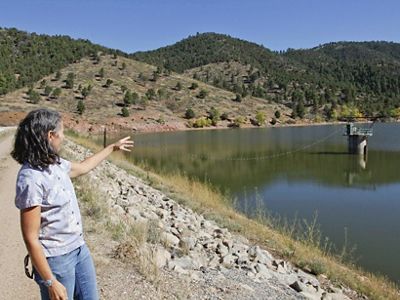Rivers and Streams
The Nature Conservancy is responding to growing threats facing our state’s critical waters.

New Mexico’s rivers, streams and springs face threats from numerous sources. Growing cities and towns increase the demand for water and energy. Dams change natural flow patterns while agricultural irrigation can remove all water from entire stream reaches. Rising temperatures from a changing climate promise to further jeopardize these life-giving resources.
In response, the Conservancy and its partners are protecting and restoring three important tributaries of the Colorado River, the West’s iconic, wild river and a critical source of water for people and wildlife. These tributaries — the Gila River, San Juan River and Rio Nutria — are stressed by redirected flows, non-native invasive plants, droughts and growing water demand.
GILA RIVER: ONE OF THE SOUTHWEST'S LAST FREE-FLOWING RIVERS
The Gila River supports extraordinary biodiversity along with thriving farming and ranching communities.
Currently, a proposed water diversion threatens the river. However, a recent poll shows that New Mexicans favor long-term, cost-effective solutions to ensure the state’s secure water future.
To address these issues, the Conservancy is:
- Advocating sustainable water management and infrastructure improvements that result in water conservation.
- Expanding the Gila River Riparian Preserve beyond the 1,300 protected acres to encompass more than 150,000 acres under conservation management in the Upper Gila and Mimbres watersheds.
SAN JUAN RIVER: THE "FOUR CORNERS" RIVER
Slicing through the canyon country of Colorado, New Mexico and Utah, the San Juan River supported six-foot long, 100-pound Colorado pikeminnows and five-foot razorback suckers until the arrival of dam construction, water diversions, oil and gas drilling and non-native species.
To bring back these now endangered behemoths and the ecosystem that supports them, the Conservancy is:
- Partnering with the San Juan River Basin Recovery Program to restore self-sustaining populations of big river fish
- Restoring fish habitat and native vegetation in partnership with the Navajo Nation, New Mexico Environment Department, and U.S. Fish and Wildlife Service
- Supporting a collaborative effort to improve water flows for fish, wildlife and people through strategic “re-operation” of the Navajo Dam
RIO NUTRIA AND MIMBRES RIVER: RARE WATERS AND UNIQUE SPECIES
These rivers harbor two fish that occur nowhere else in the U.S.: the Zuni bluehead sucker in the Rio Nutria and the Chihuahua chub in the Mimbres River. Springs along the Mimbres River also harbor other rare fish species and the endangered Chiricahua leopard frog. We are protecting these ecological treasures by:
- Establishing the Mimbres River Preserve, which conserves more than 4 miles of the river
- Collaborating with the State of New Mexico and the Gila National Forest to protect habitat on public lands located along the Mimbres River
- Working with the Zuni Pueblo and the New Mexico Department of Game and Fish to protect spring and stream habitats along the Rio Nutria, including the Conservancy’s 1,720-acre Rio Nutria Preserve
SANTA FE RIVER: PROTECTING WATER SUPPLIES AND RESOURCES
The Santa Fe River gathers in the Sangre de Cristo Mountains at the southern end of the Rockies to provide cool, clear water to residents of the high desert city that shares its name. Long a sanctuary for wildlife, the river offers a place for people to reconnect with nature. Our work here has included:
- Establishing and expanding the 525-acre Santa Fe Canyon Preserve to restore cottonwood-willow forest and other wildlife habitat, and safeguard a popular trailhead for a network of trails located on the preserve and associated city, county and Forest Service lands
- Restoring a native cottonwood-willow forest at the former Two-Mile Dam and Reservoir, which was breached and drained in 1994 to allow recovery of wetland and stream habitats and the wildlife they support
- Working with Santa Fe County and the City’s Water Division to create a world-class watershed protection project in the heart of Santa Fe
- Donating easements for the development of the City's Open Space Trail system through the Santa Fe Canyon Preserve in the foothills east of the city
RIO GRANDE: RESTORING FORESTS TO PROTECT CLEAN WATER
The Conservancy and partners have established the Rio Grande Water Fund to help protect the watershed and keep the Rio Grande River working for people and nature. In it’s first year, the Water Fund has achieved many pivotal successes.
Help Protect Fresh Water for People and Nature: Conserving and restoring New Mexico’s rivers, streams and springs makes sense for the residents who rely on them for drinking water, electricity, recreation and spiritual renewal. Your support can ensure the health and resilience of New Mexico’s rivers and fresh water around the world.
